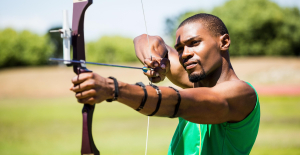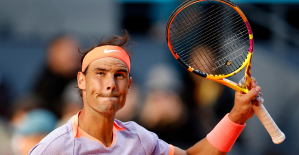When football games are canceled due to strong gusts of wind, ski areas no longer have snow in winter and long-distance runners collapse in the summer heat, the effects of climate change can also be felt in sport. High temperatures, storms and other consequences of global warming are already restricting the possibilities for exercise and in some cases endangering the health of the athletes. Sport must therefore find ways to adapt to the changes - and at the same time bears responsibility for climate protection.
If global warming continues, extreme events in sport could soon be the norm: a report warns of heat strokes among players and spectators, stadiums being flooded by heavy rain and flooded sports fields. The circle of those affected is large. The German Olympic Sports Confederation (DOSB) alone has around 27 million members in around 90,000 clubs in Germany. There are also people who keep fit outside of organized sports by jogging, hiking or cycling.
But the training not only has a positive effect on the body, direct and indirect consequences of climate change are now affecting the health of athletes. The Robert Koch Institute now lists six risk areas: heat, increased UV radiation, extreme weather conditions, increased ozone and particulate matter pollution, allergies and infections.
"Many of these risks now run through the whole year, although they are more pronounced in summer," says sports sociologist Sven Schneider, professor at the University Medical Center Mannheim. He and his team have investigated how sport could adapt to this situation. The scientists developed a model that provides a combination of so-called behavioral and situational preventive measures. "On the one hand, athletes can protect themselves according to medical guidelines," explains Schneider. "On the other hand, the framework conditions of the sport can be optimized." This benefits all athletes, regardless of how they behave individually.
A few examples: Allergy-causing pollen. Due to the mild winters, they now fly almost all year round and occur in higher concentrations. In addition, the pollutants in the air make them more and more aggressive. "Endurance athletes are particularly at risk because of their larger respiratory volume," explains Schneider. Hypoallergenic planting along the sports facilities could relieve allergy sufferers. Antihistamines or asthma sprays can also provide relief. "However, some of these drugs are on the doping list because they expand the bronchi," the sports sociologist points out.
Or the amount of rainfall. This is increasing due to climate change, but is not distributed evenly over the seasons. The winters are wetter and the summers are drier. Schneider expects increased heavy rain and flooding in the cold season. That's why he recommends athletes use the warning app from the Federal Office for Civil Protection and Disaster Assistance (NINA), which provides information about such dangers. In addition, the sports sociologist thinks it makes sense to adapt the rules of the game: "For example, the rules should define how interim results are evaluated in the event of a game being abandoned due to bad weather."
The risk of infection is also increasing due to the climate. Ticks are already more active in spring, blue-green algae can pollute water in summer, and non-native mosquito species are spreading to us. The Asian tiger mosquito, for example, now occurs regularly in Germany and can transmit more than 20 viruses, including West Nile, dengue and Zika viruses. "These are completely new health risks that climate change brings with it," says scientist Schneider. He advises joggers to wear close-fitting clothing in the warm season, use insect repellent and check the body for ticks after exercise. Canoeists should avoid rolling techniques in polluted waters and only eat provisions with disinfected hands.
However, according to an expert survey by Schneider's team, the biggest risks for athletes include heat and UV radiation. Clubs can ensure the protection of everyone involved by energetically renovating halls and stretching awnings over coaches' benches and spectator stands. In addition, the playing times can be adjusted: "A youth football game doesn't have to take place in the midday heat," says Schneider. He suggests extending the leagues' summer break and letting clubs play longer into the mild winter. With regard to UV radiation, which can be unexpectedly high as early as the end of March, individual protection for athletes is also important in order to prevent sunburn and skin cancer.
Most sports associations have so far lacked such target group-specific information. “Compared to other institutions, sport is relatively late,” says Schneider, who analyzed the websites of all 66 top DOSB associations. The result: only every fifth association provides information about UV exposure, every sixth about the danger of heat waves. "The other risks are addressed even less frequently, although they are just as relevant," he complains.
Adapting to the consequences of climate change is one thing – protecting the climate is another. Germany wants to become climate neutral by 2045. In order for this to succeed, everyone is required: "As an economic sector, sport is clearly one of the causes of climate change," claims Schneider.
If you take the largest international competitions together, it can be assumed that annual greenhouse gas emissions for global sport are estimated at ten million tons of CO₂ equivalents. This corresponds roughly to the greenhouse gases of Latvia. The majority of the emissions are due to the arrival and departure of athletes and spectators.
In addition to the emission of greenhouse gases, some sports also damage the ecosystem directly. Forests are cleared and soil leveled for ski slopes, and artificial snow has to be used in many places. According to the Federal Ministry for the Environment, the seasonal snowmaking of all ski areas in the Alps consumes around 2,100 gigawatt hours of electricity, as much as 500,000 households combined per year. They also consume immense amounts of water. According to a study, even with a massive expansion of artificial snowmaking, the number of ski areas with guaranteed snow will fall sharply in the long term.
Approaches to climate protection can be seen, for example, in football, the most popular sport among Germans. For fans combined tickets with local public transport, the arena in Sinsheim is to be developed into Germany's first zero-waste stadium. One of the world's largest solar roofs was inaugurated on a football stadium in Freiburg this year, with which the system should be able to cover its entire annual electricity requirement CO₂-free.
Nevertheless, only four of the 36 clubs in the German Football League have set themselves a binding net zero target. But that should change. A first step is the mandatory sustainability guideline, which the Bundesliga anchored in its licensing in the spring.
The English club Forest Green Rovers, which was recognized by the United Nations in 2018 as the first climate-neutral football club in the world, is a pioneer when it comes to climate protection. He uses electricity from renewable sources, has an electric team bus, collects rain to water the pitch and organizes group trips for fans. A special feature: The Forest Green Rovers eat vegan and that also applies to the food on offer in the stadium.
In German stadiums, on the other hand, sports sociologist Schneider sees room for improvement: “The range of food is often limited to the stadium sausage. There are more climate-friendly alternatives.” Schneider assumes that athletes and fans will support such changes: “Fans are part of our society and a change is taking place right now.”
"Aha! Ten minutes of everyday knowledge" is WELT's knowledge podcast. Every Tuesday and Thursday we answer everyday questions from the field of science. Subscribe to the podcast on Spotify, Apple Podcasts, Deezer, Amazon Music, among others, or directly via RSS feed.

 United States: divided on the question of presidential immunity, the Supreme Court offers respite to Trump
United States: divided on the question of presidential immunity, the Supreme Court offers respite to Trump Maurizio Molinari: “the Scurati affair, a European injury”
Maurizio Molinari: “the Scurati affair, a European injury” Hamas-Israel war: US begins construction of pier in Gaza
Hamas-Israel war: US begins construction of pier in Gaza Israel prepares to attack Rafah
Israel prepares to attack Rafah Spain is the country in the European Union with the most overqualified workers for their jobs
Spain is the country in the European Union with the most overqualified workers for their jobs Parvovirus alert, the “fifth disease” of children which has already caused the death of five babies in 2024
Parvovirus alert, the “fifth disease” of children which has already caused the death of five babies in 2024 Colorectal cancer: what to watch out for in those under 50
Colorectal cancer: what to watch out for in those under 50 H5N1 virus: traces detected in pasteurized milk in the United States
H5N1 virus: traces detected in pasteurized milk in the United States Private clinics announce a strike with “total suspension” of their activities, including emergencies, from June 3 to 5
Private clinics announce a strike with “total suspension” of their activities, including emergencies, from June 3 to 5 The Lagardère group wants to accentuate “synergies” with Vivendi, its new owner
The Lagardère group wants to accentuate “synergies” with Vivendi, its new owner The iconic tennis video game “Top Spin” returns after 13 years of absence
The iconic tennis video game “Top Spin” returns after 13 years of absence Three Stellantis automobile factories shut down due to supplier strike
Three Stellantis automobile factories shut down due to supplier strike A pre-Roman necropolis discovered in Italy during archaeological excavations
A pre-Roman necropolis discovered in Italy during archaeological excavations Searches in Guadeloupe for an investigation into the memorial dedicated to the history of slavery
Searches in Guadeloupe for an investigation into the memorial dedicated to the history of slavery Aya Nakamura in Olympic form a few hours before the Flames ceremony
Aya Nakamura in Olympic form a few hours before the Flames ceremony Psychiatrist Raphaël Gaillard elected to the French Academy
Psychiatrist Raphaël Gaillard elected to the French Academy Skoda Kodiaq 2024: a 'beast' plug-in hybrid SUV
Skoda Kodiaq 2024: a 'beast' plug-in hybrid SUV Tesla launches a new Model Y with 600 km of autonomy at a "more accessible price"
Tesla launches a new Model Y with 600 km of autonomy at a "more accessible price" The 10 best-selling cars in March 2024 in Spain: sales fall due to Easter
The 10 best-selling cars in March 2024 in Spain: sales fall due to Easter A private jet company buys more than 100 flying cars
A private jet company buys more than 100 flying cars This is how housing prices have changed in Spain in the last decade
This is how housing prices have changed in Spain in the last decade The home mortgage firm drops 10% in January and interest soars to 3.46%
The home mortgage firm drops 10% in January and interest soars to 3.46% The jewel of the Rocío de Nagüeles urbanization: a dream villa in Marbella
The jewel of the Rocío de Nagüeles urbanization: a dream villa in Marbella Rental prices grow by 7.3% in February: where does it go up and where does it go down?
Rental prices grow by 7.3% in February: where does it go up and where does it go down? Even on a mission for NATO, the Charles-de-Gaulle remains under French control, Lecornu responds to Mélenchon
Even on a mission for NATO, the Charles-de-Gaulle remains under French control, Lecornu responds to Mélenchon “Deadly Europe”, “economic decline”, immigration… What to remember from Emmanuel Macron’s speech at the Sorbonne
“Deadly Europe”, “economic decline”, immigration… What to remember from Emmanuel Macron’s speech at the Sorbonne Sale of Biogaran: The Republicans write to Emmanuel Macron
Sale of Biogaran: The Republicans write to Emmanuel Macron Europeans: “All those who claim that we don’t need Europe are liars”, criticizes Bayrou
Europeans: “All those who claim that we don’t need Europe are liars”, criticizes Bayrou These French cities that will boycott the World Cup in Qatar
These French cities that will boycott the World Cup in Qatar Archery: everything you need to know about the sport
Archery: everything you need to know about the sport Handball: “We collapsed”, regrets Nikola Karabatic after PSG-Barcelona
Handball: “We collapsed”, regrets Nikola Karabatic after PSG-Barcelona Tennis: smash, drop shot, slide... Nadal's best points for his return to Madrid (video)
Tennis: smash, drop shot, slide... Nadal's best points for his return to Madrid (video) Pro D2: Biarritz wins a significant success in Agen and takes another step towards maintaining
Pro D2: Biarritz wins a significant success in Agen and takes another step towards maintaining


















